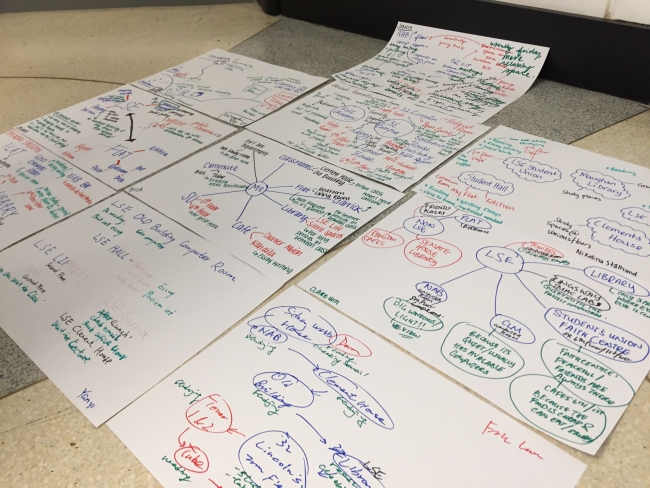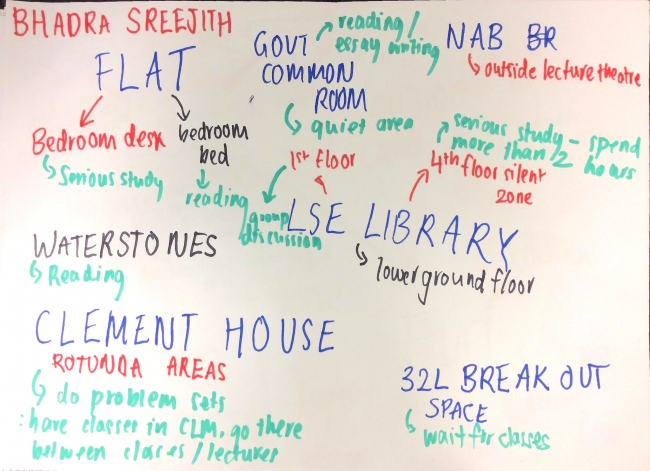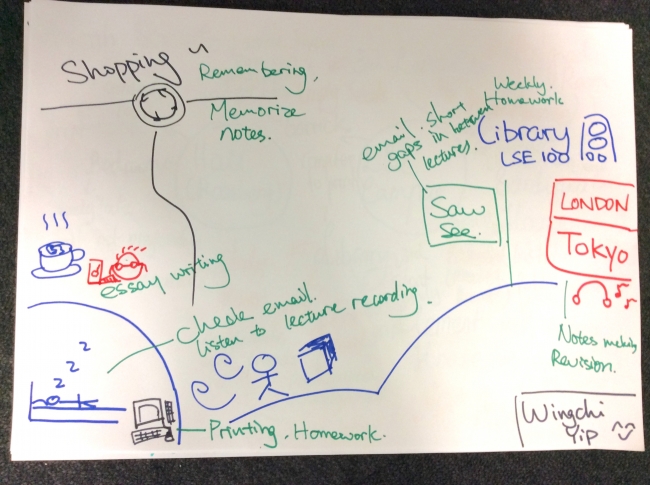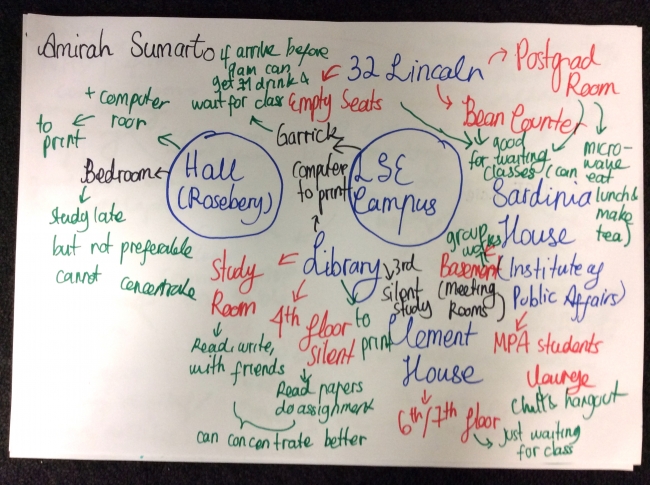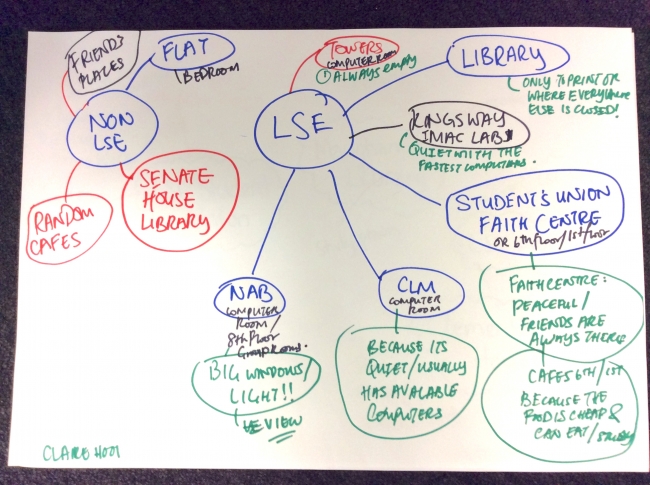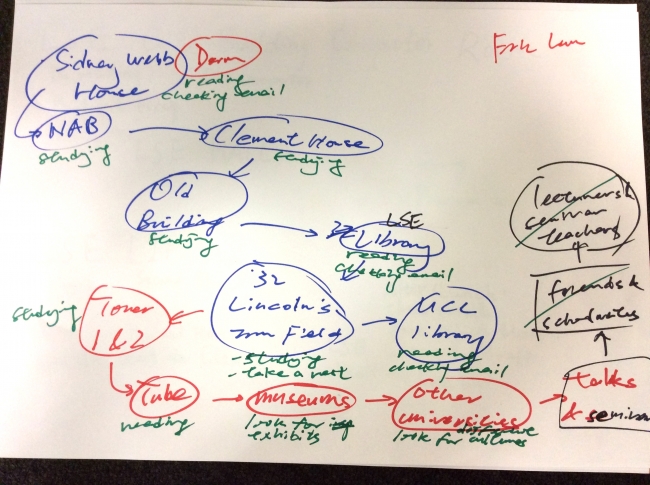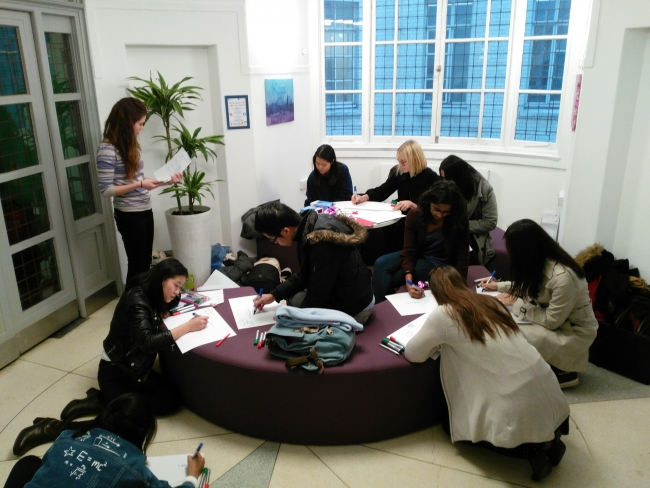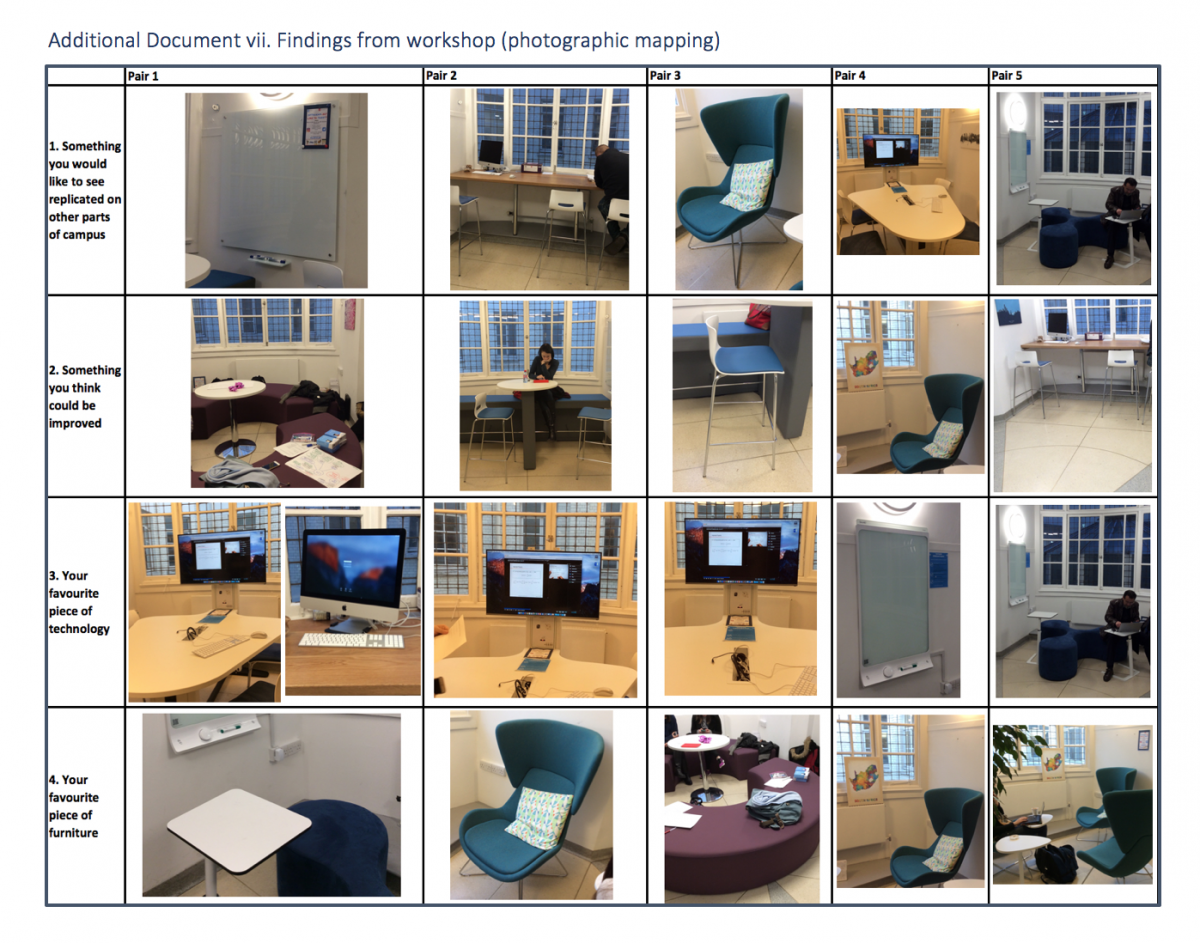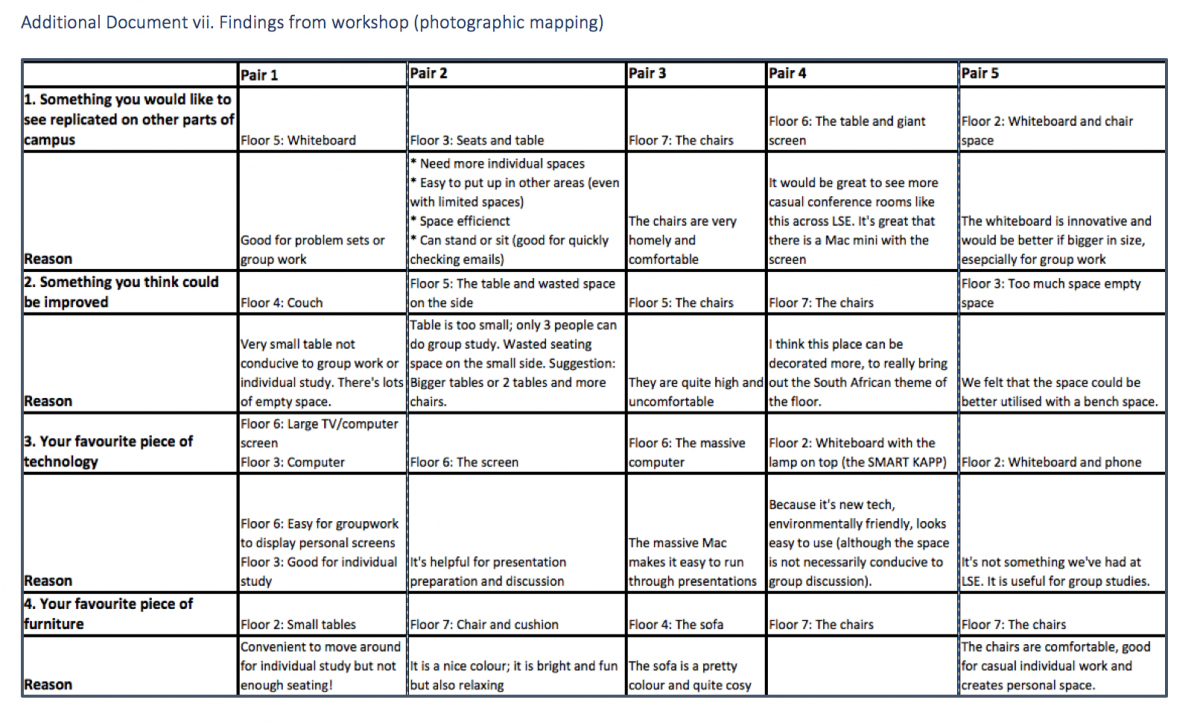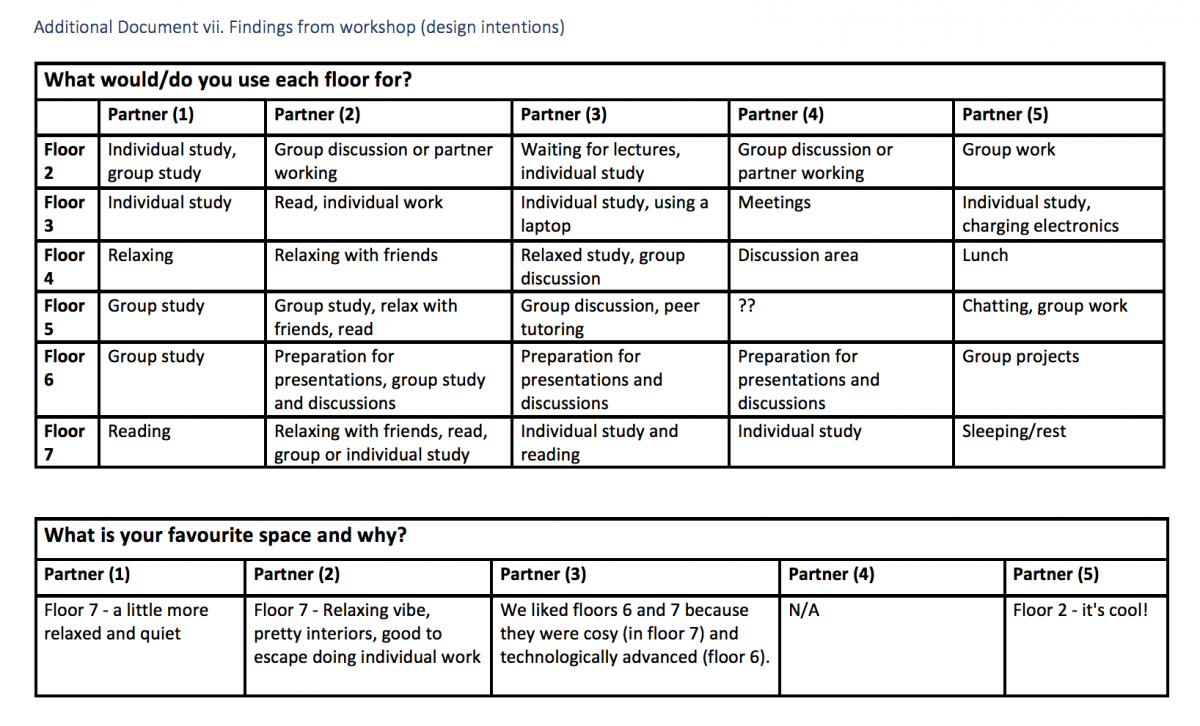This article is one of three blog posts on the newly refurbished learning spaces in Clement House. It is written by Emma Wilson, Graduate Intern for LTI. You can find her on Twitter (@MindfulEm). For more information about the Clement House evaluation, please take a look at our final report.

In 2016, LSE unveiled six refurbished informal learning spaces in Clement House.
As part of this process, we sought to uncover how spaces such as these fit into the day-to-day life of a student. To help with our enquiry, we decided to design and deliver a one-hour interactive workshop with students at LSE. We had three objectives:
- To better understand the behaviours,
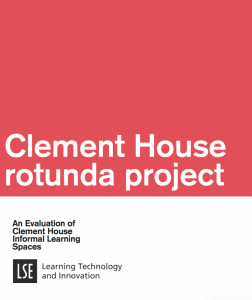 attitudes and preferences of LSE students using informal learning spaces such as those within the Clement House rotunda. Specifically, to better understand how, what, when, where and why students use particular learning spaces.
attitudes and preferences of LSE students using informal learning spaces such as those within the Clement House rotunda. Specifically, to better understand how, what, when, where and why students use particular learning spaces. - To compare the original design intentions for each floor at Clement House to how these spaces are viewed by students.
- To better understand how the Clement House spaces fit into the overall student learning experience at LSE
The workshop was divided into two parts:
- A cognitive mapping exercise
- A photographic mapping exercise
1. Cognitive Mapping
The first part of the workshop, adapted from work undertaken in the ERIAL project and developed by Donna Lanclos at UNC Charlotte, aimed to explore how the learning spaces at Clement House fit into the overall learning journey at LSE. Each student was provided with a blank sheet of A3 paper and four different coloured pens. The first part of the activity required students to list all the places in which they go to study – from the library, to a local café, to halls of residence. This part of the exercise took 6 minutes in total. Every 2 minutes, students were asked to switch the colour of their pens in this order: blue, red, black. After 6 minutes, students were asked to annotate their maps using a green pen, to say why they chose these spaces and what they do in these spaces – individual reading; group work; essay writing? By using different coloured pens, it was possible to see which locations came to the forefront of students’ minds when asked to think about places they go to study. Students were then asked to discuss their maps with the group.
2. Photographic Mapping
Building on the work at the University of Rochester, (Briden, 2007) the activity in photographic mapping asked students to take photographs of their preferred spaces at Clement House based on a list of questions:
- Something you would like to see replicated on other parts of campus.
- Something you think could be improved.
- Your favourite piece of technology.
- Your favourite piece of furniture.
Students worked in pairs and were asked to write down reasons for their photos. Following the exercise in photographic mapping, students were asked about the design intentions of each floor. This was a useful opportunity to compare student opinion with original design intentions.
Full size images of the exercise in photographic mapping can be found here: 1, 2, 3.
This workshop was an opportunity to engage with students using a creative and interactive approach. The 10 spaces for the workshop were filled in a short space of time and recruitment was conducted over Twitter and/or departmental newsletters. Participants were awarded £10 for their time and Eventbrite was used. Looking ahead to future sessions, it would be worth having 1.5 hours for the workshops in order to have more time for discussion.
The cognitive mapping exercise provided some insightful data and it was interesting to see the different approaches that students took to presenting their mind maps. Cumulatively, a total of over 40 different areas, both on- and off-campus, were cited as places where students choose to study. This signals two things: firstly, there is diversity in preference that moves beyond traditional learning spaces such as the library; secondly, the learning environment reaches far beyond the classroom walls, and stretches across the day – from checking emails on the morning commute, to finding a study space after – or in-between – class, in an area such as Clement House.
The photographic exercise was another interesting activity that highlighted the diversity of student preferences within the built learning environment. It was important to ask students the reasons behind their choices. When looking at possible improvements to the learning spaces, all of the students focused their discussion on spatial factors, such as maximising the number of tables and chairs.
Regarding the second objective – to compare the original design intentions for each floor at Clement House to how these spaces are viewed by students – it was interesting that student perception of each space contrasted to the original design intentions. Given that many of these spaces were designed to facilitate interactive group working rather than individual self-study, it is not surprising, at this stage, for a difference of opinion – at present, students are more familiar with the traditional methods of learning, rather than using interactive or static whiteboards for group discussion. Looking ahead, it is hoped that these spaces will be well-suited for LSE’s increasing focus on assessment diversification; particularly those projects which involve group work.
Further information about the workshop (including methodology, references, complete findings and discussion) can be found in the report. If you have any questions on the recruitment process or any of the activities, contact Emma Wilson (e.wilson2@lse.ac.uk).
A full version of the evaluation report, complete with the methodology used for the workshop, can be found here.
References
BRIDEN, J. 2007. Photo surveys: eliciting more than you knew to ask for. In: FOSTER, N. F. & GIBBONS, S. (eds.) Studying Students: The Undergraduate Research Project at the University of Rochester. Chicago: Association of College and Research Libraries.
ASHER, A. & MILLER, S. 2011. A Practical Guide to Ethnographic Research in Academic Libraries: The ERIAL Project.
LANCLOS, D. 2013. Playing with Cognitive Mapping. the Anthropologist in the Stacks [Online].



